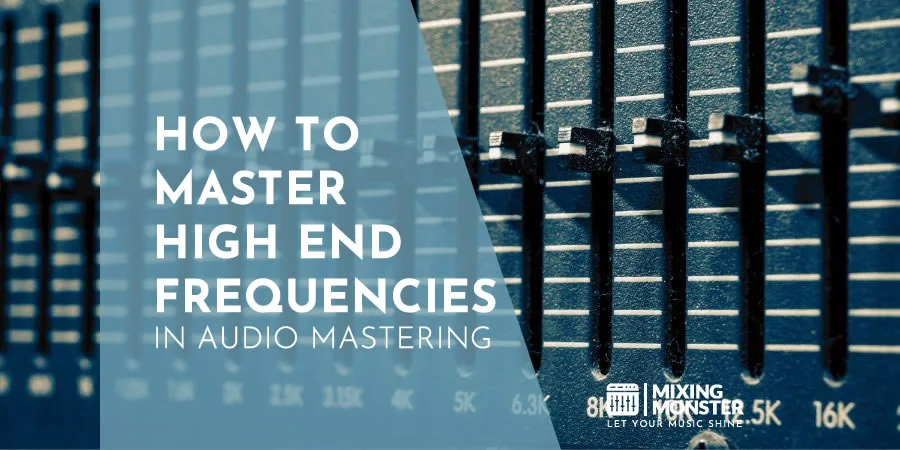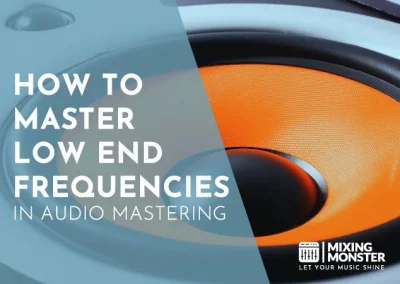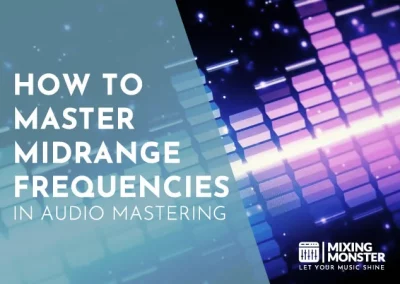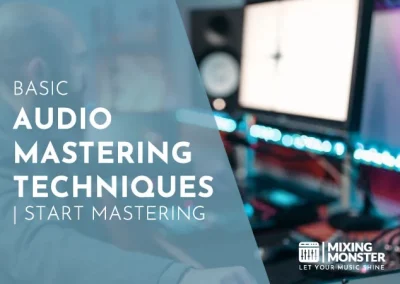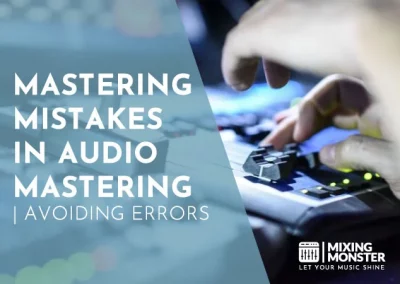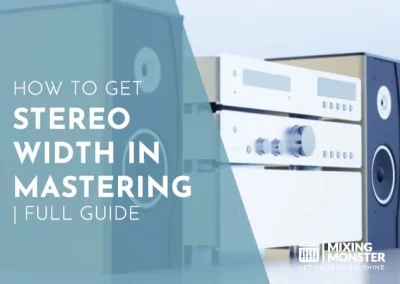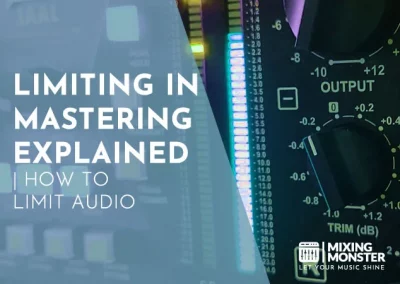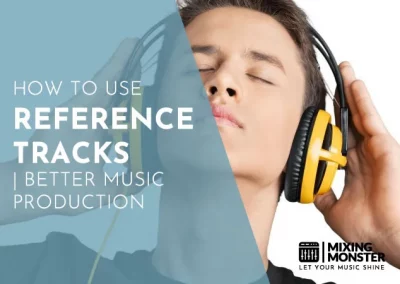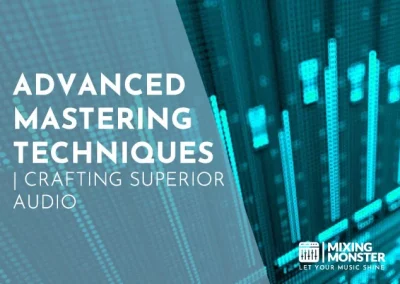Disclosure: Some of the links below are affiliate links, meaning that at no additional cost to you, we will receive a commission if you click through and make a purchase. Read our full affiliate disclosure here.
Mastering high end frequencies is essential to achieving professional-grade audio. High frequencies can provide clarity, sparkle, and the sense of ‘air’ that gives recordings a polished feel. Fortunately, with the right approach and tools, you can master high end frequencies in your productions. Understanding high end frequencies’ unique challenges and characteristics is the first step toward achieving a balanced and transparent sound. These frequencies can become harsh or piercing without careful handling, but when treated correctly, they can lift the entire mix.
Mastering high end frequencies involves using various tools and techniques effectively. Equalization (EQ) plays a crucial role in shaping the high-end by cutting or boosting frequencies to achieve the desired tonal balance. Other processes, such as compression and limiting, can also be instrumental in controlling the high-end dynamics, ensuring that they sit well in the mix without overwhelming other elements.
Advanced techniques may be necessary to resolve more complex issues and to add that final gloss to a track. By harnessing the full potential of these mastering tools, you can enhance the overall quality of your audio projects.
KEY TAKEAWAYS:
- Mastering high end frequencies adds clarity and polish to audio recordings.
- Proper EQ, compression, and limiting use are crucial in high-end frequency mastering.
- Advanced techniques can further refine high-end sounds, ensuring a well-balanced mix.
Table Of Contents
1. Overview Of How to Master High End Frequencies
2. The Tools For Mastering High End
3. EQ Techniques For High End Mastery
4. Compression And Limiting Strategies When Mastering High End
5. Advanced Techniques When Mastering High End
6. Clarity, Air And Sparkle: Master High End Properly
7. FAQ

1. Overview Of How to Master High End Frequencies
Mastering high end frequencies is crucial for ensuring your mix has clarity and presence. Let’s explore the steps to effectively control these elusive frequencies.Mastering high end frequencies is crucial for ensuring your mix has clarity and presence. Let’s explore the steps to effectively control these elusive frequencies.
Identifying Common Issues With High End In Mixes
Your experience with mixing will soon reveal that high-end frequencies can be problematic. Issues such as harshness, sibilance, or a lack of sparkle can plague a mix. Pinpointing these audio problems early is vital to achieving a balanced, professional-sounding high end.
Using Spectrum Analyzers To Visualize High Frequencies
Incorporating a spectrum analyzer into your workflow allows you to visualize the frequency spectrum. This tool helps identify problem areas that aren’t immediately apparent to the ear, ensuring that your listening experiences and analytical tools work together for a better mix.
Listening Techniques for Evaluating High End
Critical listening techniques optimize your perception of high-end audio. Adjust your listening environment to minimize reflections and ensure accurate playback. Pay particular attention to how the high frequencies sit in relation to the rest of the mix, as this will heavily influence the listener’s experience.
2. The Tools For Mastering High End
Mastering the high end of your audio involves a combination of precision equalization, dynamic control, and limiting techniques. Your choices in equipment and software can significantly influence the clarity and detail of the final sound.
Overview Of EQ, Compression, And Limiting In Mastering
Equalization (EQ) is critical in mastering to balance the high frequencies, ensuring they are crisp and detailed without becoming harsh.
Compression smooths out dynamic changes, particularly in instruments like guitars and vocals, enhancing the consistency of your sound.
With limiting, you can raise the overall volume of your track without clipping, maintaining audio integrity even at louder volumes.
Dynamic Equalizers And Multiband Compressors
Dynamic equalizers allow you to apply EQ selectively based on the signal level, giving you greater control over frequency-specific dynamics.
Multiband compressors, on the other hand, enable you to compress different frequency bands independently, which can be invaluable for managing complex components such as vocals, guitars, and amps in the mix.
Selecting The Right Tools For Your Mastering Session
Choosing the right tools can add significant value to your mastering process. Look for professional-grade EQs and compressors that offer transparent sound and fine control.
Remember, the best equipment enhances your audio without imposing its character unless specifically desired. Your selection should also align with your mastering goals, whether after a bright, modern sound or a warm, vintage vibe.
3. EQ Techniques For High End Mastery
High end frequencies give your music clarity and definition. Mastering this spectrum requires precision—knowing when to enhance and when to reduce is essential to professional-sounding audio.
The Art Of Subtle EQ Boosts And Cuts
Your approach to high end EQ should be delicate. Small boosts can add presence and definition to your mix, while slight cuts can remove harshness without affecting clarity. Use narrow Q settings (highly selective frequency ranges) to isolate and adjust specific frequencies without impacting neighboring bands.
Finding And Enhancing The 'Air' Band
The ‘air’ band typically refers to frequencies above 10 kHz and is associated with the sense of airiness and lift in audio. By using subtle gain increases in this range, you can add a sensation of energy and open up the mix, giving it a more three-dimensional feel with a sense of space.
Balancing Brightness And Harshness
Brightness should not be confused with harshness; the key is balance. To manage this, employ EQ to trim excessive high frequencies that cause listener fatigue, ensuring your audio remains bright but not abrasive. Monitor the relationship between the high end and the mids to maintain a harmonious energy distribution across the spectrum.
| Frequency Range | Recommended EQ Move | Purpose |
|---|---|---|
| 8 kHz – 9 kHz | Slight boost | Enhance presence and definition |
| 10 kHz – 12 kHz | Subtle boost (< 1.5 dB) | Add ‘air’ and openness |
| 12 kHz – 14 kHz | Conservative cut or boost | Adjust overall brightness |
| Above 15 kHz | Careful boost | Bring energy, ensure no increase in harshness |
| Problem areas | Surgical cut | Remove resonances and harsh frequencies |
4. Compression And Limiting Strategies When Mastering High End
Mastering the high end of your audio is crucial for maintaining clarity while ensuring consistent levels. Precision in compression and limiting can greatly enhance the listening experience through speakers and headphones.
Taming Peaks Without Sacrificing Clarity
When addressing the high frequencies in audio mastering, it’s critical to balance transparency with control. Use compression to tame sharp transients that can cause discomfort to the ear.
A fast attack time can be effective for catching peaks, but setting the release time is a delicate task—it needs to be quick enough to prepare for the next transient but not so fast that it causes pumping.
| Setting | Purpose | Common Values |
|---|---|---|
| Ratio | Controls the intensity of the compression once the threshold is passed | 2:1 to 4:1 |
| Attack | Determines how quickly compression starts after the threshold is exceeded | 0.5 to 3 ms |
| Release | How fast the compression stops after the signal falls below the threshold | 50 to 150 ms |
| Knee | Softens the point where compression begins to smooth out the transition | ‘Soft’ knee |
| Threshold | Sets the level where compression or limiting begins | -1 to -3 dB for limiting |
Applying Limiting For Consistent High End Levels
Limiters ensure your high end is manageable for the rest of the mix. Set your limiting to maintain consistency in the high frequencies without causing distortion. Your limiter’s threshold should be set just above the desired peak level to catch any excessive spikes, achieving a smooth and controlled top end.
Stereo Imaging In High Frequencies
Properly applied stereo imaging can widen the high end and add a sense of space, creating an immersive listening experience. When using stereo enhancement tools, be mindful of phase issues and always check your mix in mono to ensure compatibility across various playback systems.

5. Advanced Techniques When Mastering High End
Mastering high end frequencies shapes the sonic signature of your music and ensures that the final audio product translates well across various playback systems, from wireless headphones to earbuds. Utilize advanced techniques to add polish and shine to your tracks.
Harmonic Excitement For Liveliness
Harmonic excitement can be integral to ensuring that your high end frequencies add vibrancy to your track. This involves adding subtle harmonic distortion that can make the high frequencies come alive, making the overall experience more engaging. It’s a delicate process; overdo it, and you risk causing listener fatigue.
- Use plugins designed to add harmonics sparingly to brighten up the top end.
- Aim to enhance airiness without compromising the natural sound of the recording.
Mid/Side Processing For High End Enhancement
Mid/side (M/S) processing can profoundly impact the spatial design of your audio. When working with high end frequencies, M/S EQ can add width and depth, helping the high end of your mix to bloom and stand out without overshadowing the midrange.
- Mid Channel:
Focus on clarity and any necessary attenuation to prevent masking. - Side Channels:
Boost the high end slightly to add space and openness.
By carefully balancing the mid and side channel content, you create a high end that complements the audio’s spatial characteristics, making for a more immersive listening experience regardless of the listener’s choice of device, from earbuds to studio monitors.
6. Clarity, Air And Sparkle: Master High End Properly
Mastering high-end frequencies means ensuring your mix has the right balance of clarity and brilliance, which is often associated with the ‘air’ and ‘sparkle’ in a sound.
Key Takeaways For Mastering High End Frequencies
- Target Frequencies:
Identify the key high-frequency range, typically between 6 kHz to 20 kHz, which adds ‘air’ and ‘sparkle’ to your tracks. - High-Pass Filtering:
Apply high-pass filters judiciously to eliminate low-frequency rumble that can cloud high-end clarity. - De-Essing:
Use de-essing to control sibilance in vocals, often in the high-end frequency range, to prevent harshness. - Additive EQ:
Apply additive equalization with a gentle touch to enhance frequencies subtly, avoiding excessive brightness that leads to listener fatigue. - Harmonic Excitement:
Consider harmonic exciters or tape saturation plugins to add subtle harmonic content that can make the high-end shine without increasing high-frequency energy too much. - Stereo Imaging:
Utilize stereo imaging tools to widen the high-end frequencies and create a sense of openness in the stereo field. - Monitoring Environment:
Ensure your monitoring environment accurately represents high frequencies so you can make informed mastering decisions. - Reference Tracks:
Use professionally mastered reference tracks to compare and contrast the high end, aiding you in achieving a competitive sound. - Preservation Of Dynamics:
Aim to preserve the high end dynamics to maintain the music’s natural feel, especially with acoustic instruments that can benefit from nuanced high-frequency details.
Happy high end mastering!
7. FAQ
1) What Are the Signs of Poorly Mastered High End Frequencies in a Track?
Poorly mastered high end can lead to a track sounding brittle or thin. Overemphasis can cause listener fatigue, while underemphasis might make it feel lifeless.
2) How Can You Tell if High End Frequencies Are Too Harsh or Too Dull?
If your high end frequencies are too harsh, your track will sound abrasive, often causing discomfort at higher volumes. Conversely, if they’re dull, the track may lack clarity and sparkle.
3) What Are the Best Practices for EQing High End Frequencies During Mastering?
Use surgical EQ to boost or cut frequencies attentively. Apply gentle high-shelf EQ to enhance brightness or slight attenuation to reduce harshness without affecting the presence.
4) How Does Compression Affect High End Frequencies in the Mastering Process?
Compression can impact the balance of high end frequencies. Over-compression can dull the sparkle, while under-compression can leave them sounding uncontrolled.
5) What Advanced Tools Are Recommended for Mastering High End Frequencies?
Multiband compression and dynamic EQ can offer nuanced control, allowing you to address specific parts of the high end spectrum without altering the overall character.
6) How Can You Ensure High End Frequencies Translate Well Across Different Playback Systems?
Cross-reference your track on multiple systems. Make incremental adjustments to ensure that your high-end maintains clarity without overpowering large and small speakers.

